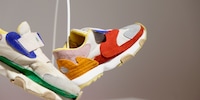
Background information
Kids’ sneaker subscription: beautiful shoes, clever concept
by Pia Seidel

Swiss industrial designer Narada Zürrer wants to revolutionise the children’s shoe market with a sneaker subscription. This week he’s our guest in the video series Design Questions, in which he talks about his project in Swiss German.
Very few final year projects ever make it out of university. Neunoi is one of them. Its goal is to create a children’s shoe prototype that’s both sustainable and reparable.. The shoe was created by designers Thibaut Wenger and Narada Zürrer and is ready to take things to the next level.
A shoemaker’s workshop in Schaffhausen has been working on producing the shoe in various sizes for the last few weeks. Now, the promising talent’s ready to be tested in everyday life. «Testing is the most important piece of the puzzle, as it should deliver representative results fairly quickly,» says Narada, who decided to continue developing Neunoi on his own after completing his degree in industrial design at Zurich University of the Arts (ZHdK).
Today, Narada is my Design Questions guest. He talks about his latest developments, how he discovered his love of design and what his guiding principle is when designing: «to question the purpose over and over again». The video shot in the shoe-making workshop is available in Swiss German only.
The Neunoi sneaker was designed together with children and has incorporated their ideas and needs. Its circular design is impressive. The inner lining’s made from second-hand sweaters, the sole’s biodegradable and replaceable, and the Velcro fastener can be changed. If the shoe’s damaged at some point, those parts are patched up with coloured bits of leftover leather from local label Petit Mai, which would otherwise be thrown away. The leather hails from a small family business based in southern Germany. For five generations, they’ve been using the same tanning methods and rely mainly on plant-based dyes free of heavy metals to reduce water pollution.
Neunoi has also integrated Japanese traditions into its design. «Wabi-sabi emphasises the beauty of imperfection, kintsugi uses gold for repairs and sashiko turns seams into works of art,» explains Narada. «Every seam and repair tells the story of the shoe and gives it a unique character.» Thereby, Narada is questioning the concept of «new» in general. What’s particularly appealing for kids is a small compartment for keeping secret things and the fact that the shoes become more unique and colourful with each repair thanks to organically shaped leather patches.
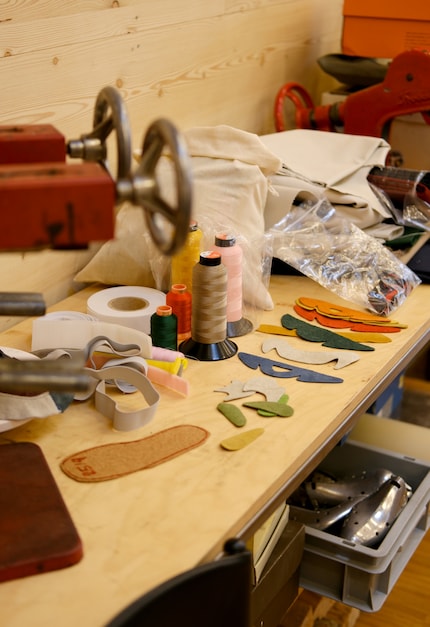
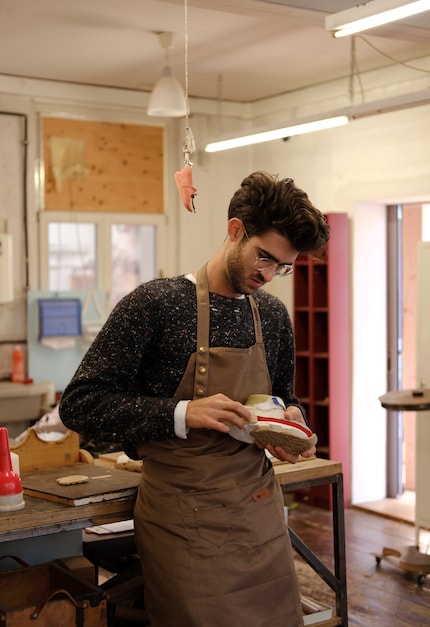
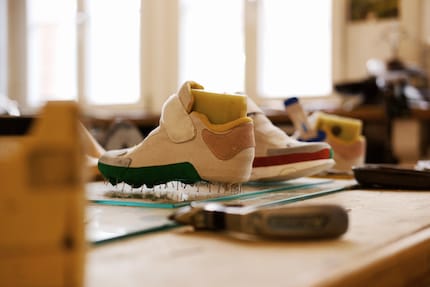
To reduce the number of shoes that are thrown out due to rapidly growing children’s feet, these sneakers will be available on a subscription basis. The subscription allows you to return a pair that have become too small so they can be repaired and reused.
To bring the subscription to market, Narada’s not only producing a shoe, but also developing a promising new business model. The challenge is to keep sustainability and Neunoi’s social values in check on the way to series production. «We want to manufacture a sustainable product in Switzerland or Europe. The next step is to define and test the manufacturing processes. Hopefully, we’ll soon be able to prove that a locally produced sneaker can be economical, too. The production of the first nine prototypes is very time-consuming and requires lots of manual work. That’s why each pair still costs several hundred francs. The aim is to be able to offer a subscription for well under CHF 30 per month in the future.»
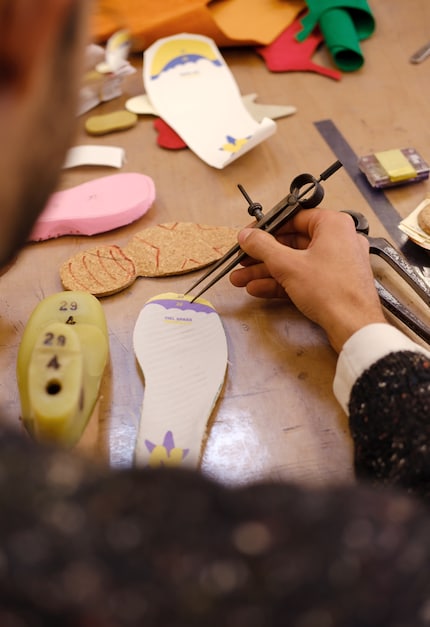
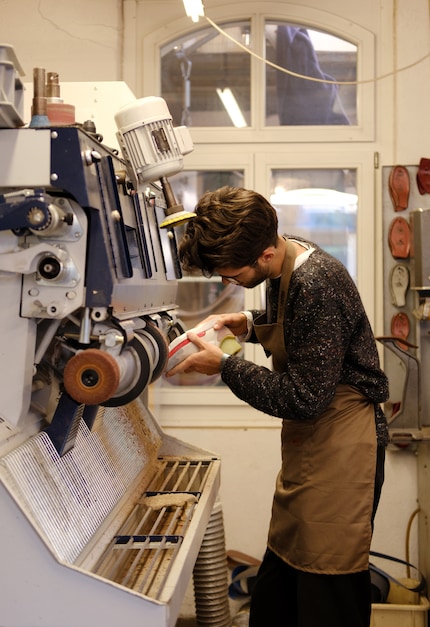
The Neunoi sneaker’s a bright young talent displaying huge potential, but still a diamond in the rough. The association Verein Atelier A (website in German) produces new prototypes at its shoemaking workshop. It’s placed working on Neunoi at the centre of its training programme and created additional capacities to bring the sports shoe to market maturity. Nevertheless, only 20 pairs can currently be produced per month. In the future, more manufacturers will be needed to cater for the growing waiting list for children’s sneakers. That’s why, in addition to the test phase, Narada’s concentrating on raising funds to strengthen the team. Neunoi’s currently being supported by initiatives such as Z-Kubator and Pro Helvetia.
With Neunoi, Narada wants to continue to work creatively with children and encourage their interest in design and sustainability. «We feel there’s a community aspect about sharing shoes,» he says. «After a child’s outgrown the shoes, we ask the family to share a story when they return them. This story is then posted on the respective product page.» Some families who took part in the test are already involved in circular design themselves. Among the first to try out the shoes are the kids of the founder of The Hole Story (site in German). The company’s dedicated to mindfully repairing clothing in order to extend its life cycle. Should a pair of children’s sneakers reach their end of life at some point, Neunoi can either dispose of all its components properly or recycle them and reuse them in production – like a player who’s not simply removed from the game after a long career, but instead shares their experience as a mentor to support the next generation.
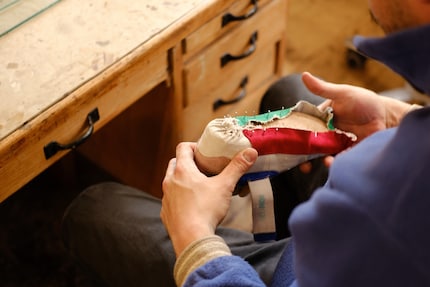
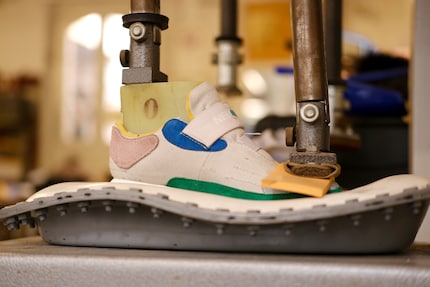
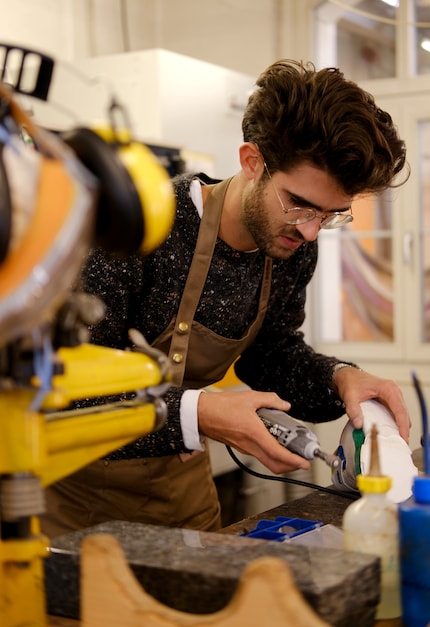
In this series of articles, designers answer questions about design and provide insights into their creative world and working methods. All within the framework of a video format.
Like a cheerleader, I love celebrating good design and bringing you closer to everything furniture- and interior design- related. I regularly curate simple yet sophisticated interior ideas, report on trends and interview creative minds about their work.
Interesting facts about products, behind-the-scenes looks at manufacturers and deep-dives on interesting people.
Show all